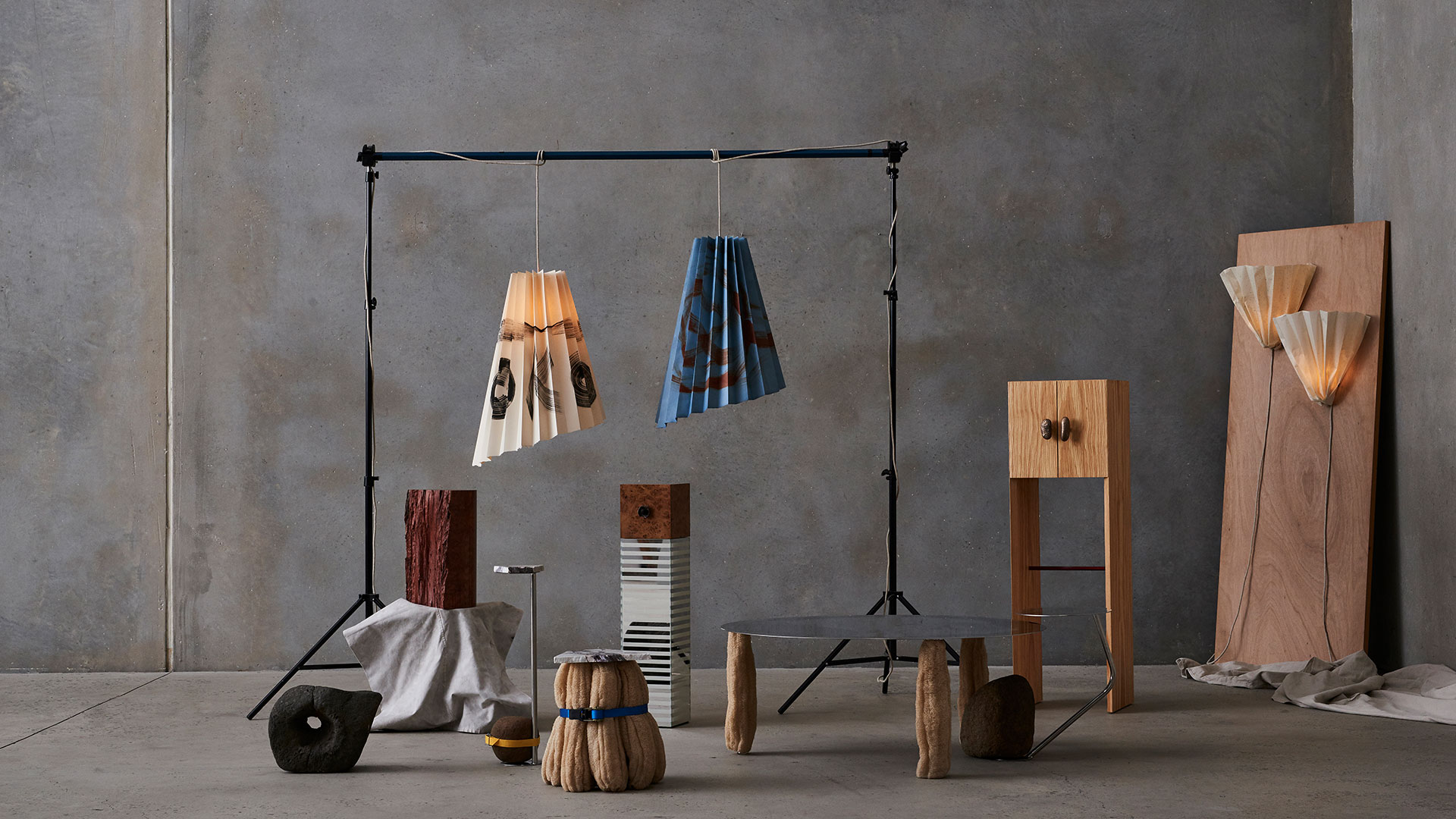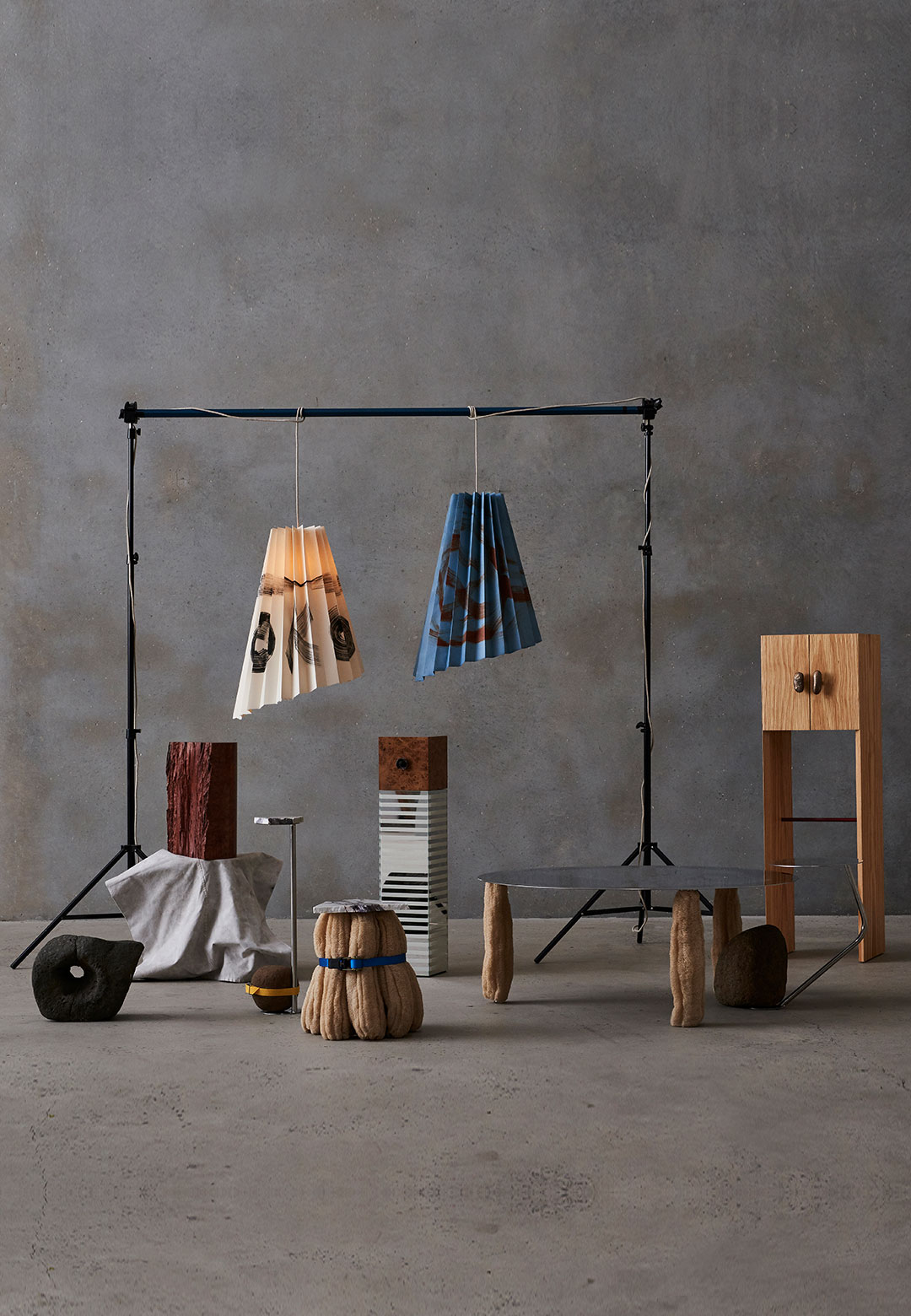A multidisciplinary studio in Australia that goes by the name of Oko Olo, is driven by the act of foraging for entities from two fringes of our habitat—the untarnished offcuts left behind by nature and the residual figments discarded from industrially built objects—and later using them to build articles of both decorative and functional natures. Founded by Genevieve Hromas and Juliet Ramsey, the multidisciplinary creative partnership in Brisbane particularly focuses on congruously combining heterogeneous materials. “We enjoy the collision of unlikely subjects, the raw versus the manufactured, the found and the formed,” Hromas and Ramsey share. Their inaugural collection, Found and Formed, alludes to this description.
Regarding the Found and Formed collection, the studio shares, “These are not solemn pieces, not to say we won’t make solemn pieces…but these ones are spirited.” A look at the tables, cabinets and lamps from the collection confirms this assertion. Every furniture piece is made using a combination of industrially produced materials and objects acquired from natural terrains. These distinct entities sit contiguously with each other, almost as if in dialogue, balancing the crudeness on one end with clean edges on the other. This process of carefully composing the raw and the refined has given form to animated pieces with distinct personalities of their own. When placed together, they exhibit a playfulness and absurdity reminiscent of Dadaism. The juxtaposition of various materials in the furniture designed does not make sense. They even appear unusable from afar, bearing semblance to parred-down animatronics built and decorated for satirical purposes. Upon closer inspection, however, they are deemed worthy of usage as functional furniture.
The Found and Formed collection was conceived by Genevieve Hromas and Juliet Ramsey, and built by Gary Galego, Luke Phillips, Lou Harris and Tyla Veney. “We are lucky to have a comprehensive local black book from our extensive industry experience, our makers are our cohorts. We are so appreciative of their practical engineering advice and indebted to the dedication of their craft,” furniture designers Hromas and Ramsey remark in appreciation of the makers who helped them build this collection of functional sculptures. “Collaborating presents a unique opportunity, it can be liberating to make something with another designer’s perspective. It releases you from what can be your echo chamber, from constantly working and thinking about things in your way. It poses a lot of questions which I enjoy,” says Gary Galego, who built Log No.1 and Mirror Plinth No.1.
With salvaged and found materials such as volcanic rocks, ceramic, ocean stones, stainless steel, timber, mirror, fabric, paper, marble and more, Oko Olo “leans into the possibilities of re-use, limiting waste and utilising a mindful archaeology of materials.” On being asked about the process of finding the materials used to the build the collection, the studio mentions, “some came from bush road trips, or beach combing, whilst others are pure industry. We have an obsessional library of still to come specimens.” While the industrial pieces used by the studio are either salvaged or fully recyclable, the timber used for the furniture design is consciously sourced. After the acquisition of these materials, Hromas and Ramsey built objects by only mildly modifying them. They refrain from tampering with found objects. Hence, the objects are “not formally attached to their counterparts.” This means that the objects can go back to where they came from, untarnished.
Oko Olo’s founders come with a combined experience of 50 years in design and art-making. Some of the areas in which Hromas and Ramsey have worked include building functional sculptures, textiles, printmaking, and interior architecture. The designers have been friends since their childhood, and their growth as creatives is informed, in part, by their intertwined experiences. Having spent their early years at a progressive school in Currambena where utopian explorations were encouraged and exposure to films, contemporary craft, fine arts and architecture was extensively facilitated, Hromas and Ramsey developed an intuitive process of making and designing. Both the creatives revere and derive inspiration from similar styles, movements and makers, and are “fascinated by the possibilities of re-imagining new purposes and combinations of found objects, through the exploration of materials from the natural and manufactured world.”
Enunciating further on various aspects of their collection, the studio shares, “Each piece is unique, honouring the characteristics of its materiality, and its counterpart: It’s the mischief in these functional sculptures that engages us. From the volcanic rock of River Rock tables to the glazed ceramic handle of Mirrored Plinth, or the cast facsimiles of ocean stone handles on The Plank Cabinet. The Illumination series opened up experimentation with paper dying and mark~making, and these glowing expressions found a place amongst their functional sculptures.” STIR scans through the several pieces that make up Oko Olo’s Found and Formed collection—made from a selection of the studio’s catalogued library of found objects.
River Rock No.1 {Counterbalance}
Made using stainless steel and diorite rock, River Rock No.1 {Counterbalance} reflects the attributes that define Oko Olo’s mantra. While the stone, the product of a past volcanic eruption in New South Wales, was acquired from a river in its vicinity, the polished stainless steel table is an industrial product. The table design is hence named since the rock acts as a counterbalance to the steel table. The designers encourage the users of the table to preserve the scratches on the polished surface, as etchings that serve as markers of the passing time.
River Rock No.2 {One Drink}
“The drink table, River Rock No.2, is a gesture to great friendships, both a solid companion and a light-hearted friend,” the studio shares. Nicknamed ‘One Drink,’ the sleek table is also built using diorite rock and stainless steel, along with a buckle strap to hold the table intact, and a shard of salvaged Calcutta Viola marble, with edges smoothened to get rid of the sharpness, affixed as the tabletop. The stone, marble and steel depict three phases of manufacture, namely raw, quarried and refined.
Luffa No.1 {Raw Composition}
In Luffa No.1 {Raw Composition}, luffa cylindrica, covering a blackened steel central support rod, is bound together with the help of raffia and a royal blue ratchet strap. Upon this vertical column sits a large shard of salvaged Calcutta Viola marble. The bound luffa cylindrica functions as an organically shaped caryatid for the stone-topped table.
Luffa No.2 {Nathan}
Similar to Luffa No.1 in the arrangement of the found and the formed entities, this iteration is a coffee table with a stainless steel top. Spanning a diameter of 1100 millimetres, the stainless steel top sits on supports made out of the same material and sheathed in luffa cylindrica, with rubber glides fitted on the feet.
Log No.1 {Vavonna}
Log No.1 {Vavonna} is a sculptural table made using salvaged blue gum log, which accommodates its new vavona skin. The log, with a soft sanded top, is split intentionally to reveal the raw torn face. “The rich lustrous reds of Australian hardwoods are often overlooked. Equally luminous, salvaged remnants of the exotic vavona burl veneer harvested from the root systems of the magnificent sequoia (coastal redwood) cloak the log,” the studio shares.
Mirrored Plinth No.1 {Folly}
Designated as a treasure box, Mirror Plinth No.1 {Folly}, is made using an oak burl veneer box with a high gloss finish for the drawer, glazed ceramic for the drawer pull, stained timber drawer handle and a birdseye maple veneer interior. It is stationed atop a floating plinth covered with a striped silver mirror.
Plank Cabinet No.1 {Solid Nostalgia}
“We chose to work on this piece because of its unusual and challenging design elements. Constantly learning and problem-solving it is what attracts us to work on a particular piece,” share Lou Harriss and Tyla Veney, who built Plank Cabinet No.1. The cabinet is made using solid radiata pine which was cerused and finished with matte oil. It stands intact on red-stained solid timber supports and is accessorised using lost wax cast bronze cabinet handles, which are facsimiles of ocean stones.
Soft Indigo {Slab Resist}
Soft Indigo {Slab Resist} celebrates the “imperfections of happenstance” with a traditional textile weaving method. Indigo dye is imprinted upon the Natural Belgium linen. Measuring 600 millimetres across all edges, the cushions come in a collection of five and warn of the scope of the indigo fading with time.
Illumination No.1, 2 and 3
While Illumination No.1 {Dark Fontana} is made up of a cream 90 GSM matte paper bathed in indigo colour-fast ink and deep red brushstrokes, Illumination No.2 {Black & Cream Fontana} bears black strokes. The bottom edges of both the lamp designs are torn, folded and sewn with a silk thread. The lamps come with a wire frame, natural cloth cord, bulb holder and ceiling canopy. Illumination No.3 {Wall Fontana}, on the other hand, is crafted with paper, which is folded and hand stitched with cotton thread to the custom-made metal frame.






 Sign in with email
Sign in with email










What do you think?